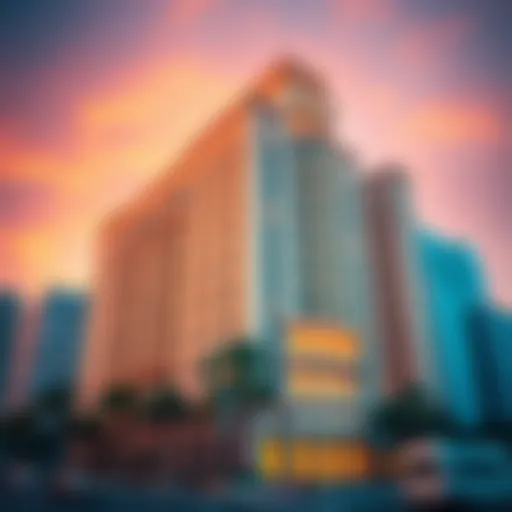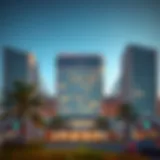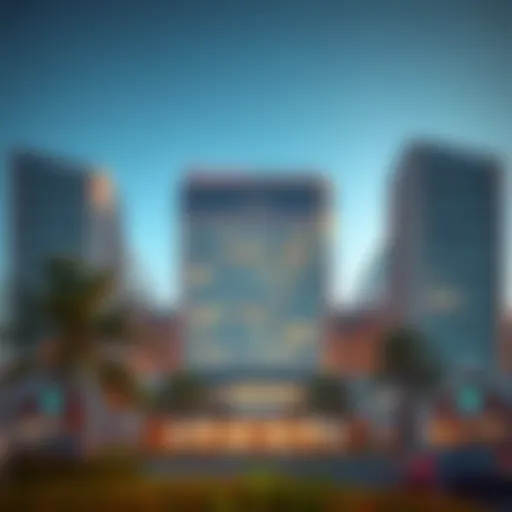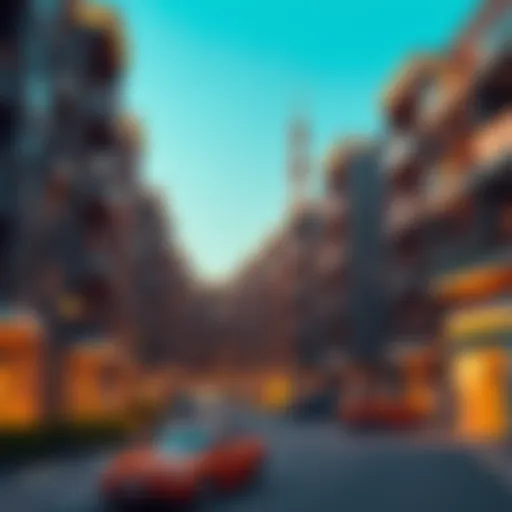Geographic Significance of Ras Al Khor in Dubai
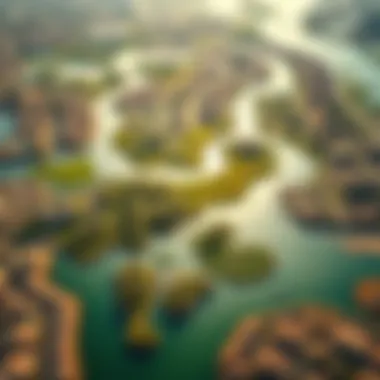
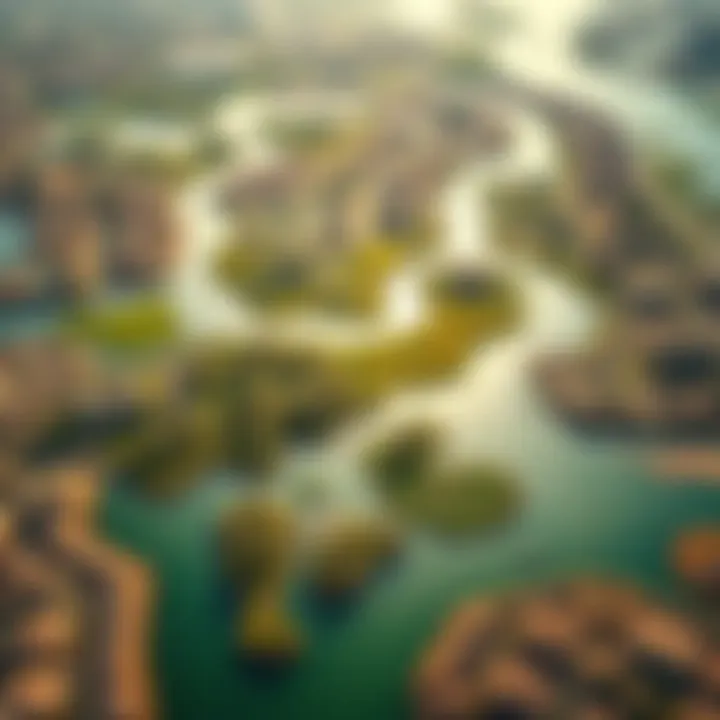
Intro
Ras Al Khor, a part of Dubai, is a unique spot that serves as a bridge between nature and urban life. Nestled along the southeastern coastline of Dubai Creek, it showcases an intriguing mix of natural habitats and human development. This area's significance goes beyond just its scenic beauty; it plays an essential role in the ecological landscape of Dubai as well as its evolving identity. Here, we will unpack the features that make Ras Al Khor a vital part of Dubai, focusing on its neighborhood traits, community life, and the synergy between its ecology and urban development.
Neighborhood Features
Landscaping Highlights
One of the standout features of Ras Al Khor is its diverse landscaping. The area boasts vast mangroves, interspersed with salt flats and lagoons that attract numerous species of birds and wildlife. This unique environment not only serves as a sanctuary for migratory birds like flamingos but also supports the intricate web of life that thrives in the region. The harmonious blend of natural and urban elements creates a distinctive character, making Ras Al Khor a vital ecological pocket in a bustling metropolis.
- Mangrove Areas: These provide essential habitats and act as barriers against coastal erosion.
- Wetlands: A crucial ecosystem supporting diverse flora and fauna, contributing to the region's biodiversity.
Architectural Styles
The architecture of Ras Al Khor reflects a blend of modernity and respect for tradition. While the urban fabric features sleek, contemporary designs, there are also nods to cultural heritage in the area. This mixture gives residents and visitors alike an engaging visual narrative that speaks to Dubai's ambitious developments while paying homage to its roots.
- Modern Designs: Buildings with glass facades and innovative layouts stand alongside.
- Cultural Inspirations: Structures that embody the historical Arabian architecture.
"Ras Al Khor’s architecture narrates a story of progress, grounding itself in tradition while reaching for the skies of modernality."
Community Life
Local Events and Activities
Community dynamics in Ras Al Khor are vibrant. The area hosts various events that engage residents and encourage active participation. From environmental clean-up days to local art exhibitions, there's always something brewing.
- Wildlife Photography Workshops: Encouraging appreciation for the natural world.
- Cultural Festivals: Celebrating the city's diverse heritage and the community's interconnectedness.
Lifestyle Amenities
Living in Ras Al Khor offers a range of lifestyle amenities that enhance the quality of life for its inhabitants. With parks, walking trails, and convenient access to commercial establishments, residents enjoy a balanced lifestyle where nature and convenience merge.
- Parks and Recreational Areas: Ideal for family outings and community gatherings.
- Local Markets and Shops: Providing fresh produce and fostering a sense of community through small-scale commerce.
For more in-depth information about Ras Al Khor’s geography and biodiversity, consider visiting resources like Wikipedia or Britannica.
Ras Al Khor is a canvas where nature, culture, and urbanity intertwine, marking its importance on the map of Dubai and highlighting its dynamic identity.
Prelude to Ras Al Khor
Ras Al Khor, a name that translates to "Cape of the Creek," is not just another spot on the map; it embodies a unique intersection of urban life and natural beauty. This area has piqued the interest of many, including homeowners, tourists, planners, and architects alike, all curious about its geographical and ecological profile. The significance of Ras Al Khor stretches beyond its physical location—it reflects the evolving narrative of Dubai itself, a city that marries ultramodern architecture with rich biodiversity.
Overview of Ras Al Khor
Nestled at the northern edge of Dubai, Ras Al Khor is characterized by its sprawling wetlands, lush mangroves, and vibrant birdlife. This region acts as a natural sanctuary, a stark contrast to the towering skyscrapers that define the city skyline. Whether it is the picturesque views or the ecological importance, Ras Al Khor serves both natural habitats and urban needs. Spanning approximately 6.2 square kilometers, the area features various lagoons, mudflats, and marshlands, contributing significantly to Dubai’s environmental landscape.
Located conveniently near major urban developments, it has become a focal point for both conservation efforts and recreational activities. Visitors are often captivated by the sight of flamingos, herons, and other migratory birds that flock to the wetlands during the cooler months. This makes it an appealing destination for birdwatchers and nature enthusiasts alike.
Historical Context
The historical backdrop of Ras Al Khor is intertwined with the growth of Dubai as a major hub for trade and commerce. Historically, this area has been pivotal for the communities that relied on the rich marine resources of the creek. Artifacts and signs of early settlements suggest that it has been inhabited for centuries, serving not only as a fishing ground but also as a waypoint for traders.
Over the years, the wetlands have faced numerous challenges, particularly with the rapid urbanization of Dubai. Despite this, there has been a concerted effort to protect and preserve the ecological character of Ras Al Khor. It stands as a testament to the balance that Dubai seeks to achieve between development and environmental sustainability. The establishment of the Ras Al Khor Wildlife Sanctuary in the early 1980s underscores this commitment, reflecting a growing awareness of the need to safeguard such an invaluable ecosystem.
Thus, the story of Ras Al Khor is not just about geography; it weaves a narrative that captures human aspiration, nature's resilience, and the ongoing quest for harmony between growth and conservation. As we delve deeper into the geographical significance of this area, it's important to recognize how these elements intertwine to shape Ras Al Khor's unique identity within the urban fabric of Dubai.
Geographical Location
The geographical location of Ras Al Khor plays a pivotal role in understanding its significance within the urban sprawl of Dubai. Situated along the eastern edge of Dubai Creek, Ras Al Khor is not just a barrier between the bustling city and the tranquil waters but a vital component in the broader ecological and urban framework. The strategic positioning of Ras Al Khor offers numerous advantages, ranging from biodiversity conservation to enhancing the city’s economic activities through its unique environmental context.
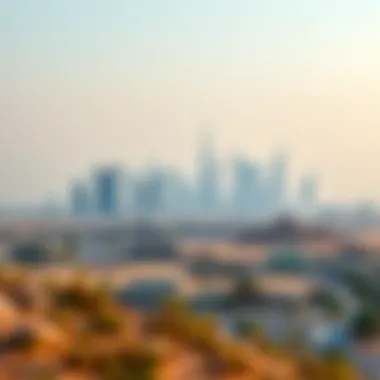
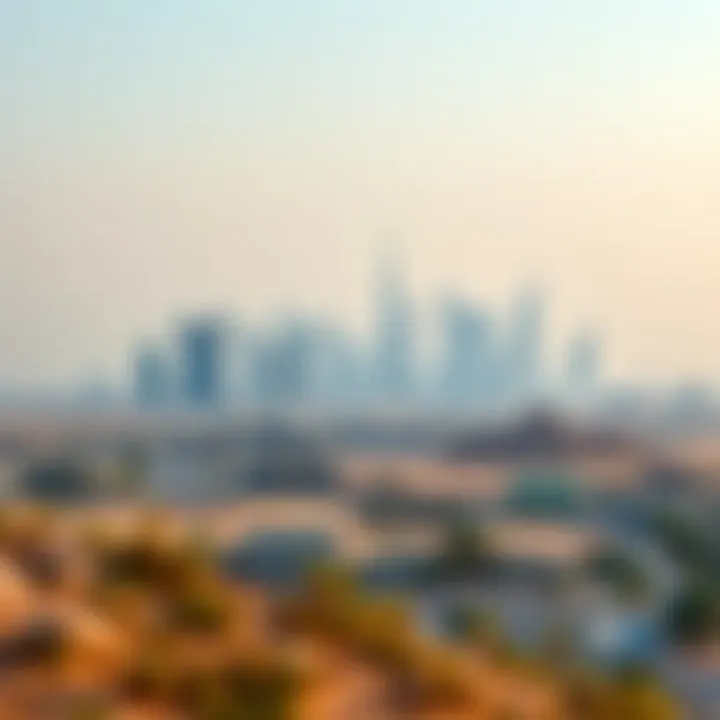
Coordinates of Ras Al Khor
Ras Al Khor is precisely located at 25.2048° N latitude and 55.3182° E longitude. This positioning places it firmly within the proximity of several key urban areas, as well as natural landmarks. It is essential to understand this geographical data as it not only identifies the location on a map but also opens the door to various ecological systems that thrive in the area. The wetlands of Ras Al Khor serve as a critical stopover for many migratory birds, making it an important ecological zone in Dubai.
Key Benefits of the Coordinates:
- Migratory Bird Sanctuary: The coordinates place Ras Al Khor in a prime location for bird conservation, crucial for avian species during migration seasons.
- Proximity to Urban Infrastructure: Close to major roads and residential areas, making it easily accessible for locals and tourists alike.
- Ecological Connectivity: Its location facilitates interaction with neighboring water bodies and coastal ecosystems.
Adjacent Areas and Landmarks
Ras Al Khor is enveloped by a variety of significant areas and landmarks that contribute richly to its character. To its north lies the city’s bustling residential projects, while the south borders the expansive desert that characterizes much of Dubai's backdrop. One notable landmark is the Ras Al Khor Wildlife Sanctuary, which plays a crucial role in conserving the natural habitats and supporting biodiverse life forms. This juxtaposition of urban development against a wildlife reserve paints a vivid picture of the symbiotic relationship between nature and humanity in Dubai.
Adjacent Areas of Interest:
- Dubai Creek: Provides a waterway facilitating trade and tourism, enhancing the importance of Ras Al Khor as a hub for both.
- Al Quoz Industrial Area: This area’s proximity bolsters economic opportunities related to tourism and environmental awareness.
- Birdwatching Points: Scattered throughout the sanctuary, these spots allow enthusiasts to appreciate the rich avifauna attracted by Ras Al Khor’s wetlands.
“The unique geographical features of Ras Al Khor exemplify the intertwining of urban life with ecological preservation, making it an area of both scenic beauty and economic relevance.”
Understanding the geographical nuances of Ras Al Khor sheds light on its essential role in Dubai’s identity. Not only does it serve as an ecological haven, but it also bridges urban growth with environmental stewardship, making it a focal point of interest for residents, visitors, and planners alike.
Ecological Features
Exploring Ras Al Khor delves into its rich ecological landscape, which plays a significant role in the environmental well-being of Dubai. Understanding these ecological features is essential, not only for appreciating the area's natural beauty but also for recognizing its importance in urban planning and conservation efforts. The wetlands, biodiversity, and unique flora and fauna found here contribute to both the ecological balance and the quality of life for nearby residents and visitors.
Significance of Wetlands
Wetlands in Ras Al Khor are more than mere bodies of water; they are vibrant ecosystems that serve multiple functions. These areas filter pollutants, manage stormwater, and provide crucial habitats for many species. Wetlands act like nature's sponges, absorbing excess rainwater and reducing flooding risk in surrounding urban areas. This natural water management system is vital for maintaining water quality and improving overall environmental resilience.
Additionally, the wetlands are a haven for migratory birds, attracting thousands of avian species each year. The presence of these birds not only enhances the area’s biodiversity but also offers educational opportunities for local communities and nature enthusiasts. The Dubai Municipality recognizes the importance of these ecosystems, and efforts are underway to protect and restore them while balancing urban growth:
"Wetlands are invaluable resources, contributing to biodiversity while also providing recreational and educational opportunities for the public."
Biodiversity in Ras Al Khor
Ras Al Khor stands out for its rich biodiversity, making it an ecological gem amidst the urban sprawl of Dubai. It hosts a variety of habitats, from sandy beaches to mangroves and mudflats, each supporting unique communities of flora and fauna. This diversity not only adds to the ecological complexity of the area but also aids in building a resilient environment capable of adapting to climate change.
The area's biodiversity includes various fish species, crustaceans, and mollusks that thrive in the warm waters. Furthermore, the strategic importance of Ras Al Khor as a stopping point for migratory birds cannot be overstated—over 450 species have been recorded here, making it a focal point for birdwatching and research. The delicate balance of this ecosystem underscores the necessity for careful management to preserve its integrity for future generations.
Flora and Fauna
The flora and fauna of Ras Al Khor present a captivating glimpse into the region's ecological tapestry. The mangroves are particularly notable, characterized by their unique root systems that stabilize shorelines and provide habitats for various marine life. They act as nurseries for many fish species and offer feeding grounds for numerous bird species.
Among the flora, species like halophytic plants are well adapted to the saline conditions, showcasing nature’s ability to thrive even in challenging environments. Add to this the resident wildlife, such as crabs, fiddler crabs, and various native fish species, and the area vividly illustrates the dynamic interplay of life within wetlands. This intricate network of life plays a crucial role in supporting not just the regional ecosystem but also contributes to global biodiversity.
In summary, the ecological features of Ras Al Khor are fundamental in understanding the area's geographical significance. Wetlands, diversity of life, and unique plant species interconnect to form a complex and vital ecosystem, balancing between urbanization and nature, thereby enriching the broader narrative of Dubai's development.
Urban Developments
In the bustling city of Dubai, urban developments are crucial. They act as catalysts that shape not only the skyline but also the social and economic landscape. Ras Al Khor, a distinctive area within Dubai, stands at the crossroads of urbanization and ecological preservation. Understanding the urban developments here provides a clearer picture of how Ras Al Khor balances growth with sustainability.
Infrastructure Overview
Adequate infrastructure is the backbone of any urban area. Ras Al Khor shows a blend of modern amenities and natural preserves, which is key for effective functioning. Roads, bridges, and other transportation links are vital, connecting Ras Al Khor to the rest of Dubai. Notably, the Ras Al Khor Road has seen improved traffic management, facilitating the flow of both commuters and tourists.
To support the increasing population, housing developments have emerged to cater to various socio-economic groups. Residential towers overlook the wetlands, showcasing how urban life can coexist with nature. Public facilities such as community centers and parks are also part of the infrastructure debate. These elements promote social interaction, offering spaces for gathering and recreation that foster a sense of community.
Additionally, local businesses are sprouting, providing services from dining to retail. This economic vibrancy not only generates jobs but also enhances the overall quality of life for residents. Infrastructure development also considers environmental impacts and promotes eco-friendly practices within construction, as part of a broader aim to ensure that urban growth does not come at the expense of natural resources.
Impact of Urbanization
Urbanization in Ras Al Khor presents both challenges and opportunities. The influx of people into this area has significant implications for the local ecosystem and community fabric. On one hand, urban growth can lead to increased economic activity and improved living conditions. However, the consequences of rapid development can be multifaceted. Urban sprawl often encroaches on wetlands, threatening wildlife habitats and diminishing biodiversity.
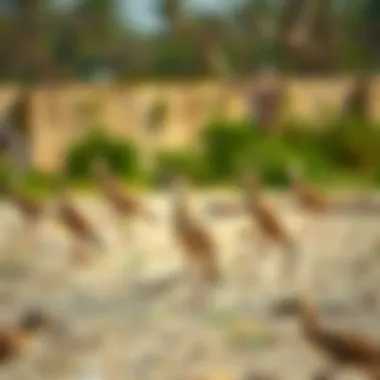

Consider the case of the flamingo population, known to flock to the salt flats and marshes of Ras Al Khor. As skyscrapers rise, the delicate balance of this ecosystem is put at risk. Protecting these natural habitats while accommodating an expanding urban populace requires innovative planning strategies.
Urbanization must be a dance between progress and preservation, ensuring an equilibrium where both communities and ecosystems thrive.
This means implementing green building standards and zoning regulations that prioritize ecological considerations. Importantly, it’s about finding that sweet spot where urban benefits do not override nature's needs.
The residents of Ras Al Khor are increasingly aware of these dynamics, engaging in community dialogues about future developments. Local governance plays a vital role, encouraging participation and implementing policies that reflect the aspirations of the community. By looking to the future, Ras Al Khor can serve as a model for sustainable urban development within the context of a rapidly growing metropolis.
In summary, urban developments in Ras Al Khor illustrate the complexity of urbanization in a city like Dubai. Infrastructure serves as the foundation for a thriving community, while the impact of urban growth necessitates careful stewardship of the area's unique ecological features. Through responsible planning and collaboration, Ras Al Khor stands to become an exemplary instance of how urban spaces can nurture both people and the environment.
Cultural Significance
Ras Al Khor is not merely a geographical landmark; it embodies profound cultural dimensions that reflect the identity of Dubai. The region stands as a meeting point of tradition and modernity, showcasing how communities can thrive alongside natural habitats. This cultural significance is not just about historical artifacts or architectural marvels; it's deeply intertwined with the experiences and interactions of the people who inhabit or visit this area.
Community Engagement
Community engagement in Ras Al Khor plays a pivotal role in nurturing a shared sense of belonging and purpose. Local residents often participate in activities that foster connections among diverse groups, ranging from indigenous families to expatriates. For instance, weekend markets commonly buzz with life, where vendors display handicrafts and fresh produce while storytelling sessions and traditional music resonate in the background.
The inclusivity seen in Ras Al Khor showcases a melting pot of traditions. This is evident in how local schools integrate cultural education into their curriculums, engaging students in celebrating local festivals or participating in environmental protection initiatives around the wetlands. When communities come together for beach clean-ups or planting drives, they're not just working towards preserving their natural heritage – they're also creating lasting bonds.
“The strength of a community is built on the ties that bring people together.”
Such engagement enriches not only the social fabric but also contributes to the broader narrative of urban life in Dubai, amplifying the area’s cultural pulse while nurturing future generations aware of their surroundings.
Cultural Events and Festivals
Throughout the year, Ras Al Khor is alive with various cultural events and festivals. These celebrations serve as an important vehicle for cultural expression and social cohesion. During the annual Dubai Food Festival, local chefs highlight traditional Emirati dishes, inviting attendees from all over to experience the unique flavors of the region.
Moreover, Ras Al Khor hosts events tied to the UAE's history, such as the UAE National Day, where fireworks light up the sky, and music reverberates through the streets. Each year, the area also embraces the migratory patterns of birds with eco-centric festivals that raise awareness about avian species inhabiting the wetlands. These gatherings, often filled with educational workshops and guided nature walks, underscore Ras Al Khor's commitment to conservation and community education.
The blend of cultural activities not only entertains but also educates audiences about the richness of the UAE's heritage and the importance of preserving the natural ecosystems in the face of urbanization. Hence, Ras Al Khor ultimately stands as a vibrant backdrop for cultural celebrations that foster unity, respect for nature, and cultural pride among both residents and visitors alike.
For more insights on cultural heritage and community relations in urban settings, you can visit pages like Wikipedia's UAE Heritage or explore discussions on Reddit.
Tourism and Attractions
Tourism plays an essential role in highlighting the geographic significance of Ras Al Khor. Situated within the bustling city of Dubai, this area presents a unique blend of urban development and ecological preservation. The draw of Ras Al Khor is multi-faceted, connecting visitors not only to some remarkable natural landscapes but also to local culture and amenities. Here, tourism isn’t just about sightseeing; it’s about experiencing the delicate balance between man-made structures and natural habitats. This can lead to a broader appreciation for conservation efforts in such urban contexts.
Visitor Statistics
The numbers tell an interesting story about the appeal of Ras Al Khor. For instance, visitors flock to the Ras Al Khor Wildlife Sanctuary, which alone attracts over 40,000 visitors annually. This figure highlights the area's allure, providing a sanctuary for a multitude of migratory birds, especially during the winter months. The growing influx of eco-tourists is also evident in various events hosted throughout the year, emphasizing a desire for authentic experiences that bridge nature and urban living. Notably, many visitors are drawn from diverse backgrounds, encompassing both local citizens and international tourists, thereby enriching the cultural tapestry of the area.
Several factors contribute to these rising numbers:
- Accessibility: Proximity to key urban centers and major highways.
- Awareness: Increased promotion of ecological and heritage tourism.
- Education: Opportunities for learning about local ecosystems and wildlife conservation.
Key Attractions in the Area
When it comes to attractions, Ras Al Khor packs a punch, offering a blend of recreational, educational, and cultural experiences that cater to a wide range of interests.
- Ras Al Khor Wildlife Sanctuary: The crown jewel of the area, this sanctuary is a birdwatcher’s paradise, home to over 450 species of birds, including the majestic flamingos. Each winter, large flocks of these birds migrate here, creating a spectacular sight against the backdrop of Dubai's skyline.
- Dubai Creek: This historic waterway offers a glimpse into Dubai's past. Visitors can take a traditional abra ride, providing a unique perspective of the juxtaposition between the old and the new, as modern architecture looms over traditional dhows floating in the creek.
- Heritage Village: For those looking to delve into the cultural fabric of the region, the Heritage Village offers insight into the traditional lifestyles of Emiratis. With exhibits showcasing artisanal crafts and cultural practices, it serves as a stellar educational site for tourists.
- Birdwatching Sites: There are dedicated birdwatching platforms throughout the sanctuary, equipped with educational signage. These sites allow for quiet observation, making it easier for visitors to appreciate the biodiversity without disturbing the wildlife.
- Outdoor Activities: Beyond wildlife, Ras Al Khor provides numerous recreational opportunities like cycling paths and nature trails. These not only promote physical activity but also enhance visitor engagement with the abundant flora and fauna.
In Ras Al Khor, the line between urbanity and nature blurs beautifully, inviting people to witness how both can survive side by side.
Environmental Challenges
Understanding the environmental challenges that Ras Al Khor faces is crucial to preserving its unique habitats and ensuring the continued vitality of this region in Dubai. As urbanization marches forward, various factors threaten the delicate balance of ecosystems present here. These challenges not only pertain to the environment itself but also reflect on the planning, policy-making, and activities of both residents and authorities interested in sustainable development.
Threats to Ecosystem
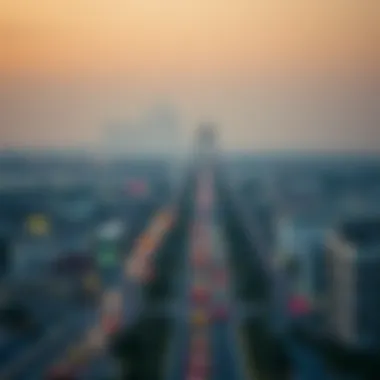

Ras Al Khor is known for its rich biodiversity, including important habitats like mangroves, tidal mudflats, and shallow waters that support a variety of flora and fauna. However, this delicate environment is under siege from several threats:
- Pollution: The proximity to urban areas means that pollutants from industries and wastewater can contaminate the waters and soil. Oil spills and heavy metals have been found to adversely affect marine life, which is critical to maintaining ecological balance.
- Urban Expansion: As Dubai continues to grow, the demand for land for buildings, roads, and other infrastructure puts immense pressure on the natural environment. Land reclamation has, in some instances, led to the loss of vital habitats that support local wildlife.
- Climate Change: Rising sea levels and changes in weather patterns are altering the landscape and habitats in Ras Al Khor. For example, higher temperatures can affect breeding cycles and migratory patterns of birds, potentially leading to a decline in species that rely on these ecosystems.
- Invasive Species: Non-native species can disrupt local ecosystems, outcompeting native organisms and leading to declines in biodiversity. This can be seen in some parts of Ras Al Khor where invasive plants are starting to dominate, affecting the delicate balance of local flora.
Understanding these threats is essential, as they can have cascading effects not just on the wildlife but also on the human communities that depend on these ecosystems for their livelihood.
Conservation Efforts
In response to these challenges, various conservation efforts are being initiated to protect Ras Al Khor's ecosystems while fostering sustainable development. These initiatives aim to mitigate the threats and rejuvenate the natural environment:
- Protected Areas: Ras Al Khor has been designated as a protected area under the Dubai Municipality’s framework. This provides a legal structure to mitigate human interference while preserving biodiversity.
- Educational Programs: Local authorities and environmental organizations are running programs aimed at educating the public about the importance of conservation. Knowledge dissemination is critical for fostering a sense of responsibility among residents and encouraging sustainable practices.
- Monitoring Systems: Implementing advanced monitoring systems helps in tracking changes in the ecosystem. Data collection regarding water quality, wildlife populations, and vegetation health allows for timely actions to be taken before issues escalate.
- Collaborative Approaches: Engaging with various stakeholders, from government bodies to local communities, plays a vital role in addressing environmental challenges. Initiatives that promote collaboration between conservationists and urban planners are now being emphasized, which ensures that development does not come at the expense of the environment.
"The essence of our urban identity rests on how we balance development with ecological preservation. Ras Al Khor showcases that possibility."
The integration of these conservation efforts is gradually helping to harmonize the relationship between urban development and the ecosystems in Ras Al Khor, thus paving the way for a more sustainable future.
Future Developments
Future developments in Ras Al Khor present a fascinating lens through which to examine the evolving urban landscape of Dubai. The significance of this section lies in understanding how infrastructural improvements and urban strategies can affect not only the local environment but also the socio-economic fabric of the area. With an eye toward growth, planners and architects are looking to balance modernization with sustainability, ensuring that the unique ecological characteristics of Ras Al Khor are preserved even amid expansion.
Urban Planning Initiatives
Urban planning initiatives in Ras Al Khor are tailored to truly reflect the complex interplay between urban living and environmental stewardship. As the region becomes increasingly tied to Dubai’s growth, several key initiatives are being discussed and implemented:
- Integrated transport systems: The development of interconnected transport links is crucial. New routes and public transit options aim to reduce congestion, which has historically been a concern in urban environments.
- Mixed-use developments: By incorporating residential, commercial, and recreational spaces into single projects, these developments promise to cater to the community's diverse needs. Such designs help foster interactions among diverse groups while remaining convenient.
- Green spaces and parks: Certain initiatives focus on creating parks and recreational areas that emphasize local flora and fauna, fortifying the region’s ecological essence while providing leisure alternatives for residents and visitors.
It's imperative that these initiatives are not just about building more; they should incorporate smart technology and sustainable practices from the outset. This approach sets the tone for vibrant, cohesive neighborhoods that resonate both environmentally and socially.
Sustainability Goals
Addressing sustainability goals in the context of Ras Al Khor is not merely a theoretical concept but a necessary step in practicalities. Several dimensions illustrate the urgency and relevance of these goals:
- Water conservation: Given the natural wetland areas, implementing water-saving technologies and rainwater harvesting practices can significantly minimize stress on local water reserves.
- Energy efficiency: Future developments are increasingly focusing on energy-efficient designs. By integrating solar panels and using sustainable materials, new constructions can significantly lower carbon footprints.
- Community awareness programs: Engaging residents in sustainability initiatives is part and parcel of urban planning. Education about the importance of conserving local ecosystems can inspire a sense of stewardship among the populace.
"Sustainability is about meeting our own needs without compromising the ability of future generations to meet theirs."
The goals set forth in Ras Al Khor are a stark reminder that progress in urban development does not have to come at the cost of ecological degradation. Instead, it should pave the way for a harmonious relationship between progress and preservation.
Finale
The exploration of Ras Al Khor through this article unveils its multifaceted contributions to Dubai's urban tapestry. As a crucial ecological zone, Ras Al Khor provides essential habitats for diverse wildlife, serving not only as a sanctuary for migratory birds but also as a crucial buffer against urban sprawl. The unique geographical positioning of this area plays a significant role in shaping both community engagement and the local economy.
In summary, this article has highlighted several key elements that underline the importance of Ras Al Khor:
- The integration of ecological functions within urban settings, establishing a balance between nature and development.
- The area's role in promoting biodiversity, contributing to the ecological richness of Dubai.
- The cultural assets and community activities that resonate with both residents and visitors alike, showcasing a lifestyle intertwined with nature.
Moreover, considering the future developments in urban planning and sustainability, it becomes increasingly clear that Ras Al Khor is pivotal in supporting Dubai’s ambitious goals. Its preservation not only benefits the environment but also enhances the quality of life for those living in and around this district.
"Urban spaces need pockets of nature to thrive. Ras Al Khor exemplifies what can be achieved when we weave ecological considerations into the fabric of city life."
Ultimately, Ras Al Khor's significance transcends its geographic footprint. It offers valuable lessons in conservation, community participation, and cultural appreciation.
Summary of Insights
Ras Al Khor stands as an essential feature in Dubai’s landscape, characterized by its vibrant wetlands and rich biodiversity. The insights from this article have shed light on how this ecological haven:
- Provides a refuge for various bird species, earning it recognition as a Ramsar site.
- Balances urban development with environmental stewardship, showing a clear commitment to sustainable growth.
- Enriches the cultural fabric of the community through festivals and engagement activities, fostering a connection between residents and the environment.
Indeed, Ras Al Khor is not just a location; it is a testament to Dubai's innovative approach to integrating environmental consciousness into urban living.
Reflections on Ras Al Khor's Role in Dubai
Reflecting on Ras Al Khor’s role in Dubai highlights several vital aspects. The area acts as a critical node in the urban ecosystem, emphasizing the necessity for urban planners and decision-makers to prioritize green spaces. As a crucial habitat, it facilitates an environment where citizens can engage with nature, promoting not only biodiversity but also a sense of community identity.
The development strategies surrounding Ras Al Khor illustrate a commitment to enhancing the standard of living through ecological preservation. In light of evolving urban challenges, this area serves as an example for other regions attempting similar balances.
To conclude, Ras Al Khor is more than an ecological site; it is a mirror reflecting Dubai's aspirations for a sustainable and interconnected urban future.



